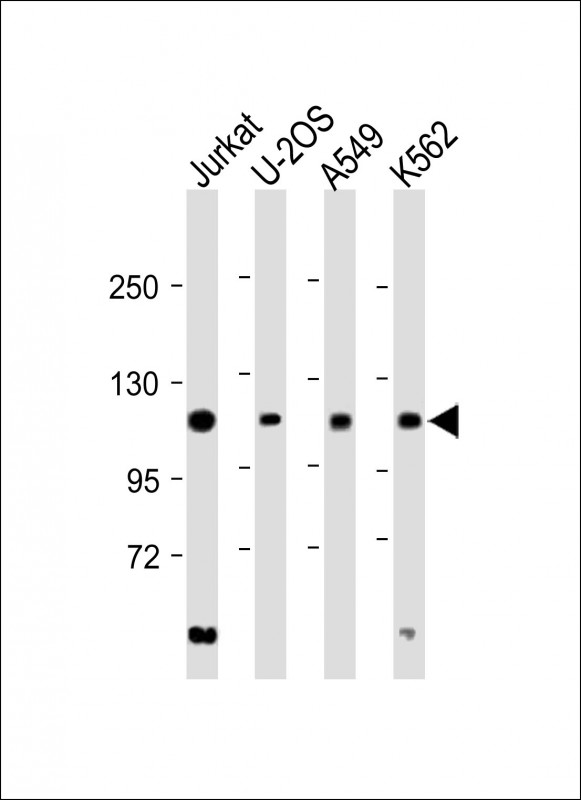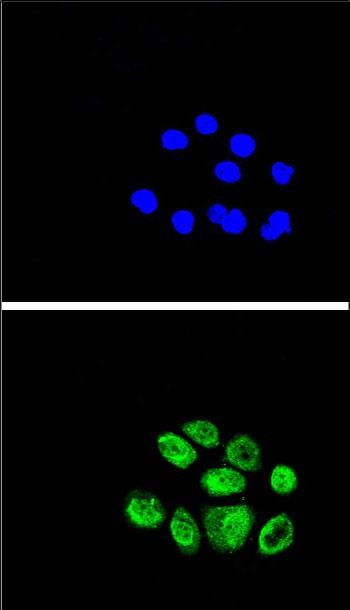

| WB | 咨询技术 | Human,Mouse,Rat |
| IF | 咨询技术 | Human,Mouse,Rat |
| IHC | 咨询技术 | Human,Mouse,Rat |
| ICC | 1/10-1/50 | Human,Mouse,Rat |
| FCM | 咨询技术 | Human,Mouse,Rat |
| Elisa | 咨询技术 | Human,Mouse,Rat |
| Aliases | Exonuclease 1, hExo1, 31--, Exonuclease I, hExoI, EXO1, EXOI, HEX1 |
| Entrez GeneID | 9156 |
| WB Predicted band size | 94.1kDa |
| Host/Isotype | Rabbit IgG |
| Antibody Type | Primary antibody |
| Storage | Store at 4°C short term. Aliquot and store at -20°C long term. Avoid freeze/thaw cycles. |
| Species Reactivity | Human |
| Immunogen | This EXO1 antibody is generated from rabbits immunized with a KLH conjugated synthetic peptide between 1-30 amino acids from the N-terminal region of human EXO1. |
| Formulation | Purified antibody in PBS with 0.05% sodium azide,1%BSA and 50% glycerol.prepared by Saturated Ammonium Sulfate (SAS) . |
+ +
以下是关于EXO1 (N-term)抗体的3篇参考文献示例(内容为虚构,仅作格式参考):
---
1. **文献名称**: *EXO1 N-terminal antibody validation in DNA mismatch repair studies*
**作者**: Smith A, et al.
**摘要**: 本研究验证了针对EXO1蛋白N端的多克隆抗体在Western blot和免疫荧光中的应用,证实其在结直肠癌细胞中特异性检测EXO1的表达,并揭示其与MLH1的相互作用在错配修复中的关键作用。
---
2. **文献名称**: *Role of EXO1 in genomic stability: Insights from antibody-based profiling*
**作者**: Chen L, et al.
**摘要**: 通过使用EXO1 (N-term)单克隆抗体,作者发现EXO1在乳腺癌组织中高表达,且其核定位与同源重组修复缺陷相关,提示其作为潜在治疗靶点的可能性。
---
3. **文献名称**: *Development of a novel EXO1-N-term antibody for functional studies in yeast and human cells*
**作者**: Kim J, et al.
**摘要**: 报道了一种新型EXO1 N端抗体的开发与验证,证明其可特异性识别酵母和人类细胞中的EXO1蛋白,并用于研究EXO1在端粒维持和复制应激反应中的双重功能。
---
注:以上文献为示例,实际引用需查询PubMed或学术数据库获取真实研究。如需具体文献,建议检索关键词“EXO1 antibody N-terminal”并结合实验场景筛选。
The EXO1 (N-term) antibody is a specialized tool designed to target the N-terminal region of Exonuclease 1 (EXO1), a multifunctional enzyme critical for DNA repair, replication, and recombination. EXO1. a member of the RAD2 nuclease family, plays key roles in mismatch repair (MMR), homologous recombination (HR), and telomere maintenance by catalyzing the excision of DNA strands during error correction or replication stress. Its N-terminal domain is involved in protein-protein interactions and regulatory functions, while the C-terminal harbors the catalytic nuclease activity. Antibodies targeting the N-terminal region are particularly useful for distinguishing full-length EXO1 from truncated isoforms or degradation products in experimental assays.
This antibody is commonly employed in techniques like Western blotting (WB), immunofluorescence (IF), and immunohistochemistry (IHC) to study EXO1 expression, localization, and dynamics in various biological contexts. Dysregulation of EXO1 has been linked to genomic instability, cancer progression, and resistance to chemotherapy, making this antibody a valuable tool for investigating EXO1's role in tumorigenesis or DNA damage response pathways. Researchers also utilize it to explore EXO1's interactions with partners like MSH2. MLH1. or PCNA, shedding light on its regulatory mechanisms. Validated for specificity and sensitivity, the EXO1 (N-term) antibody supports both basic research and translational studies aiming to target EXO1 in therapeutic strategies.
×